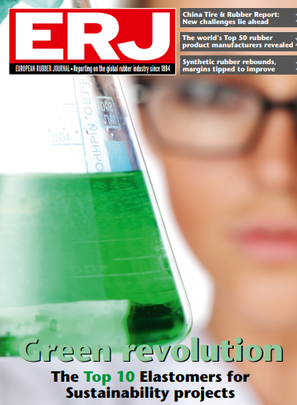Latest revision of the E4S ranking of projects based on their potential contribution to raising the environmental profile of the elastomers/rubber industry
London – An increasing pace and depth of innovation among suppliers of synthetic rubber and other raw materials in addressing environmental challenges is reflected in ERJ’s new Elastomers for Sustainability Top 10 ranking (see below).
Table-topper Techsyn impressed the E4S judges with the collaborative approach taken by its partners to fast-track the development of tire compounds offering significant improvements in rolling-resistance and wear properties.
With a clear commercial roadmap, the joint project between Arlanxeo, Bridgestone and Solvay was seen as offering “a model for accelerated R&D programmes in the rubber/tire industry,” according to the expert panel.
Performance enhancements such as wear-efficiency improvement of up to 30%, mean the Techsyn project could also make a “big contribution” to the reduction of microplastics and scrap-tire arisings.
Eni company Versalis was a close second with its project to introduce styrenic block copolymers (SBCs) based on feedstock monomers obtained from renewable sources via the mass-balance approach and certified using ISCC+ methodology,
The panel described this entry as a “strong sustainability project" and saw a "good chance of success for this innovation right at the heart of the synthetic rubber production process and linked to the mass-balance approach."
Italy-based Versalis also scored highly with a related ISCC certification project covering the production of a range of elastomers using bio-naphta feedstock at its plants in Ravenna, Ferrara, Mantova, Porto Marghera and Brindisi.
Even without a project update – leading to a 10% score-reduction – ExxonMobil Chemical still maintained a top-three position in the latest E4S table for its development of a new speciality elastomer that enhance the barrier performance of tire inner-liners.
As was noted in the previous E4S rankings, the project is closely attuned to the drive to new-mobility with its requirements for new levels of sustainability, safety and performance.
ExxonMobil’s industry-leading R&D efforts also extend to automotive components, as evidenced by its fifth-placed project to develop TPV integrated systems for sustainable glass run channel weatherseals.
The panel was impressed by the potential to use up to 50% post-consumer recyclate in the profile, with one judge commenting “lots of potential especially in auto and should be jumped on by OE’s for commercial support.”
Straight in at no 4 in the E4S table is UPM Biochemcials, with a project to convert sustainably sourced wood into renewable functional fillers (RFFs) for applications in the tire and rubber industries.
RFFs will be produced at UPM’s new €550-million biorefinery at Leuna, Germany, which has capacity to produce about 200kt of various bio-based products. The fillers are currently produced at a pilot-scale for material testing and development in elastomer applications with various OE partners.
Asahi Kasei’s development of new-generation functionalised styrene-butadiene rubber topped the very first E4S programme in mid-2020, and the judges welcomed the return of this highly impressive project with significant updates.
The company reported a “very positive response” to the technology from tire makers around the world with some grades set to be commercialised in 2021/22. Meanwhile, using advanced data-based R&D, Asahi has further optimised the polymer structure, resulting in a further 10% reduction of rolling resistance.
JSR's new hydrogenated styrene-butadiene rubber maintained its place in the top 10. The panel were impressed by the application of unique polymerisation and hydrogenation technology to improve all aspects of the ‘magic triangle’ – including a 50% improvement in wear resistance compared to conventional tire compounds.
The Japanese company has also now charted with new ‘super soft olefinic thermoplastic vulcanizates’, produced via advanced rubber polymerisation and dynamic cross-linking technologies.
The resulting TPVs, said JSR, exhibit excellent injection moulding suitability and light-weighting and could offer an alternative to EPDM in dynamic automotive sealing systems.
As well as the Techsyn project, Arlanxeo features separately on the E4S table with its continued development of compounds based on EPDM rubbers incorporating bio-monomers and bio-ingredients. A commercialisation deal with an unnamed footwear company marks a significant step-up for the Keltan Eco project.

Further details of all these E4S projects, and about the Top 10 programme, are featured in the July/August edition of European Rubber Journal magazine.




